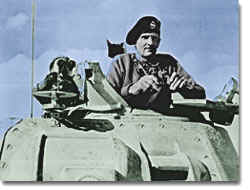| HOME |
Hitler had benefited from Stalin's cooperation in Poland and from Soviet oil and grain shipments. But Hitler's agenda involved securing lebensraum (living room) for Germanic people and the destruction of Bolshevism. Both lay eastward in the Soviet Union. In late 1940, Hitler and his generals began to plan Operation Barbarossa, the invasion of the Soviet Union. Hitler's opening of the eastern front was a bold move. Could the Soviets stop the blitzkrieg? Or would an attack stretch Hitler's forces too thin? To prepare for the invasion of the Soviet Union, Nazi forces first secured the Balkan (or southern) flank. Their Italian allies had proved unable to establish any kind of military presence in North Africa or in Greece. Nazi troops in Africa, the famous Afrika Korps led by Colonel Erwin Rommel, wrested control of Libya from the British in the spring of 1941. Conquering North Africa would give the Nazis control of the Mediterranean Sea and the Suez Canal. In April 1941, German troops also invaded Greece, defeating Greek, British, Australian, and New Zealand forces. On June 22, 1941, Operation Barbarossa commenced. The invasion of the Soviet Union was the largest in history to that point — 3,600 tanks and 2,700 warplanes supported 146 infantry divisions. As in 1940, the Wehrmacht attacked in three separate waves, unleashing its blitzkrieg approach on Soviet defenses. The early losses of Soviet troops and tanks stagger the mind. In the first three months of the Soviet offensive, roughly 2.5 million Soviet soldiers were killed, wounded, or captured. Russians, considered "subhuman" by Nazi racial beliefs, were executed en masse. Stalin was stunned. Although he never trusted Hitler completely, he never counted on a Nazi attack so soon. During the purges of the 1930s, Stalin had killed many of the top Soviet military minds, leaving an inexperienced officer corps to lead the Soviet resistance. The Nazi armies rampaged their way across Russia, coming within 20 miles of Moscow. But it had come at a cost. Over 15% of the Nazi troops had been killed or wounded. Tank losses were high. And in December 1941, a Red Army counteroffensive knocked the German army backwards. The German blitzkrieg got mired in mud and snow and sub-zero temperatures. Nazi war planners also miscalculated Soviet fighting potential, as millions of Russian reserves flocked to defend their country. A war of attrition ensued, with the numerically superior Russians holding the advantage. Resistance by Russian citizens prompted brutal retaliation from Nazi forces, which sometimes killed 50 citizens for each German soldier killed. Several Russian villages were wiped out as punishment. The Soviets adopted a scorched-earth policy, burning their homes, destroying their crops, and poisoning their water, leaving the advancing German armies with few supplies or shelters. Hitler soon learned the lesson Napoleon had learned over a century before. Attacking Russia in the wintertime was doomed to failure. In the winter of 1942-1943, the Germany army captured Stalingrad after bitter fighting. But a Soviet counteroffensive retook the city. On February 1, 1943, the Battle of Stalingrad ended with a German general surrendering his troops. About 150,000 Germans had died in the fighting, and another 30,000 were captured. The surrender damaged German morale and crushed Hitler's dream of conquering the Soviet Union. The Battle of Stalingrad proved to be the turning point on the eastern front. Hitler's forces also suffered losses in the Mediterranean and in North Africa. Rommel, the "Desert Fox," had driven the Afrika Corps to victories in British-controlled Egypt in the spring of 1942. At stake were the enormous oil resources of the Middle East. The British waged a brilliant operation in the "Desert War," blocking German and Italian reinforcements and supplies, breaking Nazi codes, and building up an impressive battle force. In the famous Third Battle of El Alamein, British forces prevented Rommel's troops and tanks from advancing into Cairo and drove them back into Libya. By this time, the United States had entered the war. Helped by an Anglo-American invasion of Morocco and Algeria, German and Italian control of North Africa was over by May 1943. The Allies' victories in North Africa enabled them to stage a dramatic invasion of Sicily in July 1943. The invasion led to the retreat of German forces, which bolstered defense lines on the Italian mainland. Fearing a collapse, King Victor Emmanuel III arrested Mussolini. On Hitler's orders, Nazi parachutists rescued Mussolini and installed him as a puppet ruler of Italy. But an invasion of the Italian mainland in September prompted the new Italian government to surrender to the Allies. A month later, it declared war on Germany, its former partner in war. Hitler had overextended his country's forces. Blinded by his racial hatred and his fantasies of repopulating Soviet Russia with Germans, he waged war on three fronts, often overruling his experienced military commanders in the process. And after Japan's bombing of Pearl Harbor on December 7, 1941, Hitler declared war on the United States, which accelerated America's buildup, and reinforced its commitment to fighting in Europe as well as in Asia. By the end of 1943, it remained to be seen whether Hitler's Thousand Year Reich was destined for glory or doomed to ruin. |
||
| MAIN | |||
| INVESTIGATION CENTRAL | |||

|
|||

